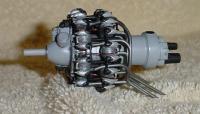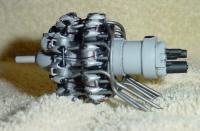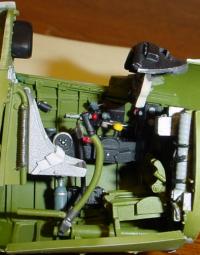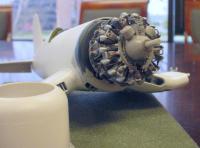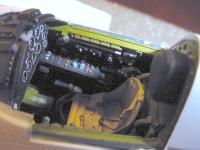The "Bent-Wing Bird" or "Whistling Death" or just Corsair. Whatever you decide to call
it, which may depend on which side of its guns you are no, the F4U Corsair was one of the most
distinctive aircraft of World War II. Its dual-dihedral wing and traditional dark blue
upper color gave it an appearance that could be confused with no other aircraft of its day.
The wing shape of the Corsair was not an accident nor was it done for aesthetics.
It was inherent in the design of the airframe. The engine powering the Corsair, the
Pratt and Whitney R-2800-8 "Double Wasp" was, at the time, the most powerful engine ever
installed in an aircraft. It was a dual-row, 18-cylinder radial engine with a
displacement of 2,804 cubic inches (that is just under 46 liters for the metric fans!)
generating over 2,000 horsepower. To harness that energy required a Hamilton Standard
propeller that was 13'-4" in diameter. Add to that the necessity for propeller clearance
over rough landing fields, and the compression of the landing struts on hard carrier landings,
the designers had two choices: 1) Landing gear that was very tall and very spindly on a
"Normal" wing, or 2) Landing gear that was short and sturdy on a "Bent" wing. They chose
the latter, the Corsair was built, and history was made.
The airplane was designed in 1938 and first flown in 1940. It was the first American
fighter plane to top 400 mph. It was designed by Vought Aircraft Company, and during the
war years was built by three companies: Brewster, Goodyear, and Vought. A total of 12,571
Corsairs of 24 variants were built. Of those 11,798 were built during the WWII years and
773 in subsequent years. Of those Vought built 7,830 and Goodyear and Brewster built the
remainder.
In 1952 the last of the Corsair line, designated the F4U-7, was delivered to the French under
terms of the Mutual Defense Assistance Program making it the last piston powered fighter
aircraft to be produced in the United States. Even though Corsair production finally
reached a halt with the delivery of these 94 F4U-7s, Corsairs continued to see service for
many years thereafter.
| F4U-1 SPECIFICATIONS (other variants will vary) |
| Wing Span: | 40.9 ft |
| Overall Length: | 33.3 ft |
| Height: | 16.1 ft |
| Empty Weight: | 8,982 lbs |
| Gross Weight: | 14,009 lbs |
| Fuel Capacity: | 537 gallons (internal fuel (273 gal) plus two 150-gal drop tanks = standard maximum fuel (537 gal). Internal fuel (237gal) plus three 170-gal drop tanks = absolute maximum fuel (747 gal). |
| Oil Capacity: | 20 gal |
| Engine: | Pratt & Whitney 18 cylinder, twin row air cooled radial, R-2800-8 |
| Horsepower: | 2,000 + (depending on variant) |
| Max. Speed (sea level): | 425 mph |
| Cruise Speed (sea level): | 186 mph |
| Range at Cruise Speed: | 1,015 mi |
| Initial Rate Of Climb: | 3,100 ft/min |
| Service Ceiling: | 37,000 ft |
| Armament: | Six .50 caliber machine guns |
| CONSTRUCTION NOTES: |
| 1 |
The kit comes with two sets of decals, one
for VMF-312 "Checkerboards" and one for VMF-351. The decals for VMF-312 are actually from
the Confederate Air Force's reconstruction of the aircraft, and one of the decals (that goes
below the horizontal stabilizer) reads "Confederate Air Force" and "N9964Z". If you choose
to apply this decal, be sure to leave all ordnance and the gun sight off! The CAF's F4u-1D
(actually it is an FG1-D) does not have any ordnance nor does it have a gunsight. The original
aircraft did not carry any CAF livery nor did it have a civil aircraft registration number.
|
|
| 2 |
Part number E-22 (I think) is not molded correctly, or I broke mine and never realized it.
It is one of the cartridge belts for the machine gun in the left wing. When the belts are
installed into the belt compartment they should all three be staggered so that they align with
the guns. The outermost belt (I think it is part E-22) is the same length as the middle
belt and if it is glued all the way against the end of the compartment as shown in the
instructions it will not line up with the breech of the machine gun.
|
|

